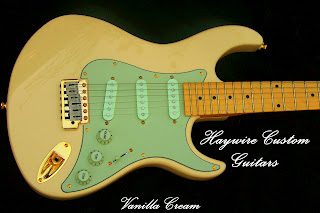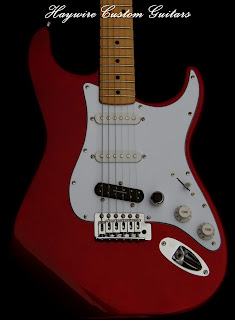An Additional Tone Control On An Electric Guitar
An electric guitar has an additional tone control built into it. Players almost never use it because they can't find it. Here is a tip and something we do often in the Custom Shop at Haywire Guitars. If you want to lose a bit of the jangly sound in your guitar tones, whether playing live or in a studio, then try this: lower the pickups. The farther away from the pickups the "healthier" the sound and the more pleasing the frequencies will be. When the pickups are farther away from the strings they tend to accentuate the bass tones and lose some of the higher frequencies which can be offensive.
The proximity of the pickups from the strings will allow the guitar another source of tonal range you didn't know was available! Think of this as and extra tone control. The adjustment acts much like a tone control. The pickups on electric guitars are adjustable for height because players want either higher or lower "action" but the side adjuster screws of the pickups have another "surprise" benefit which is to change the tone if you choose as well as getting them out of the way to afford lower action. Try it!
Proper pickup adjustment is not as optional as you may think. You'll find the sound of the pickups is a bit truer when not so close to the strings. As the string vibrates just before the pickup has a chance to "hear it" and when there is more distance between it and the string-then the sound a chance to "mature" a bit before reaching the amp-thus giving you a more rich and melodic tone and one more way to change the sound to what YOU like!
The proximity of the pickups from the strings will allow the guitar another source of tonal range you didn't know was available! Think of this as and extra tone control. The adjustment acts much like a tone control. The pickups on electric guitars are adjustable for height because players want either higher or lower "action" but the side adjuster screws of the pickups have another "surprise" benefit which is to change the tone if you choose as well as getting them out of the way to afford lower action. Try it!
Proper pickup adjustment is not as optional as you may think. You'll find the sound of the pickups is a bit truer when not so close to the strings. As the string vibrates just before the pickup has a chance to "hear it" and when there is more distance between it and the string-then the sound a chance to "mature" a bit before reaching the amp-thus giving you a more rich and melodic tone and one more way to change the sound to what YOU like!



